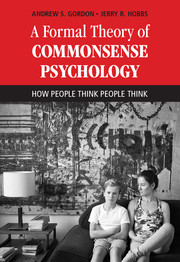Book contents
- Frontmatter
- Contents
- Part I Commonsense Psychology
- Part II Background Theories
- Part III Commonsense Psychology Theories
- 21 Knowledge Management
- 22 Similarity Comparisons
- 23 Memory
- 24 Envisioning
- 25 Explanation
- 26 Managing Expectations
- 27 Other-Agent Reasoning
- 28 Goals
- 29 Goal Themes
- 30 Threats and Threat Detection
- 31 Plans
- 32 Goal Management
- 33 Execution Envisionment
- 34 Causes of Failure
- 35 Plan Elements
- 36 Planning Modalities
- 37 Planning Goals
- 38 Plan Construction
- 39 Plan Adaptation
- 40 Design
- 41 Decisions
- 42 Scheduling
- 43 Monitoring
- 44 Execution Modalities
- 45 Execution Control
- 46 Repetitive Execution
- 47 Mind–Body Interaction
- 48 Observation of Plan Executions
- 49 Emotions
- Appendix A First-Order Logic
- References
- Index
35 - Plan Elements
from Part III - Commonsense Psychology Theories
Published online by Cambridge University Press: 01 September 2017
- Frontmatter
- Contents
- Part I Commonsense Psychology
- Part II Background Theories
- Part III Commonsense Psychology Theories
- 21 Knowledge Management
- 22 Similarity Comparisons
- 23 Memory
- 24 Envisioning
- 25 Explanation
- 26 Managing Expectations
- 27 Other-Agent Reasoning
- 28 Goals
- 29 Goal Themes
- 30 Threats and Threat Detection
- 31 Plans
- 32 Goal Management
- 33 Execution Envisionment
- 34 Causes of Failure
- 35 Plan Elements
- 36 Planning Modalities
- 37 Planning Goals
- 38 Plan Construction
- 39 Plan Adaptation
- 40 Design
- 41 Decisions
- 42 Scheduling
- 43 Monitoring
- 44 Execution Modalities
- 45 Execution Control
- 46 Repetitive Execution
- 47 Mind–Body Interaction
- 48 Observation of Plan Executions
- 49 Emotions
- Appendix A First-Order Logic
- References
- Index
Summary
Suppose we are watching a workman doing his job.He looks around for his toolbox, and when he finds it, he opens it and takes out a hammer and nails. He pounds one nail after another into boards. Each step in this repetitive action is itself a repetitive action, hitting the nail with the hammer again and again until it is flush with the wood. He sweats, and from time to time as the sweat drips into his eyes, he takes out a handkerchief and wipes his brow. Five o'clock comes, and he puts his tools away and goes home. He comes back the next morning at nine o'clock for a day of similar tasks.
The workman has a goal he is trying to achieve, and he breaks this into subgoals that eventually bottom out in individual actions and bring him closer to the satisfaction of the goals. He needs to have certain tools and resources to do his job, and to have these, he needs to know where they are – resource preconditions and knowledge preconditions. He generally engages in repetitive actions because each repetition brings him a little closer to his goal. Situations arise and have to be dealt with immediately. To do his job, he has to be able to see, and when something interferes with this, he must somehow counteract it. His job is embedded in a larger structure of plans for his life as a whole, and this has to be aligned with periodic regularities of his physical and social environment. Thus, the fine structure of his actions emerges from his manipulations of the causal structure of the world as organized in his plans.
We as observers see individual actions happening one after the other.We make sense of them in part by recognizing similarities in successive actions and thereby recognizing repetitions.We see an action happening occasionally and realize it happens only when some condition arises.We thereby recognize conditional events.We see that some actions happen only at particular times or for particular durations. By these means we recognize the temporal structure of complex events, but we have not really interpreted his actions until we understand the causal structure implicit in them, that is, until we have recognized the plan he is executing.
- Type
- Chapter
- Information
- A Formal Theory of Commonsense PsychologyHow People Think People Think, pp. 387 - 391Publisher: Cambridge University PressPrint publication year: 2017



